Text
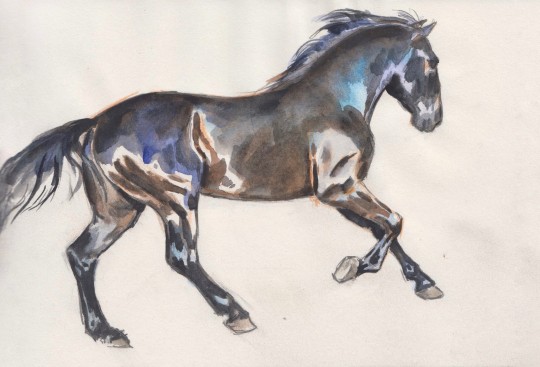
Watercolour painting of a black PRE horse.
#art#artist#artists on tumblr#horse#animal art#horses#equineart#horse art#watercolour#watercolor painting#watercolor#horseblr#pre#pura raza española#andalusian#watercolour illustration#watercolour painting#horse breeds#black horse
861 notes
·
View notes
Note
I'm none too familiar with horse breeds aside from what little media and video games (red dead redemption 2) I played but I wanted to ask: What're your favorite kind of horses? I'm a fan of Draft-esque horses. Huge, big hooves, built like tree trunks but look fantastic to give pets to.
oOOOHHH what a wonderful question!!
first off i do love draft horses a lot!! especially the ones with feathered heels (THE FLUFFY STUFF ON THEIR FEET) one of my therapy horses was a tinker horse very much like this:

and she was absolutely wonderful to work with.. though the feathers actually a lot of work to keep clean and healthy, lots of scrubbing and trimming so the horse doesn't end up stepping on them (which feels bad)
anyway ANYWAY some of my favorite breeds (in no order because it really depends on the day and hour of the day what i love the most, and i love them all equally anyway, so)
Friesian Horse
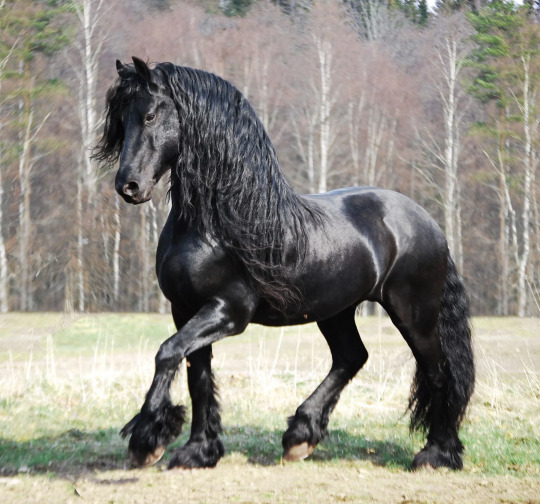
they are *gorgeous* and in my opinion, like the perfect balance between a cold-blood horse and a warmblood one! the strength of a draft horse and the elegance of a lighter, warmblood horse!! they look like an actual dream...
Norwegian Fjord Horse
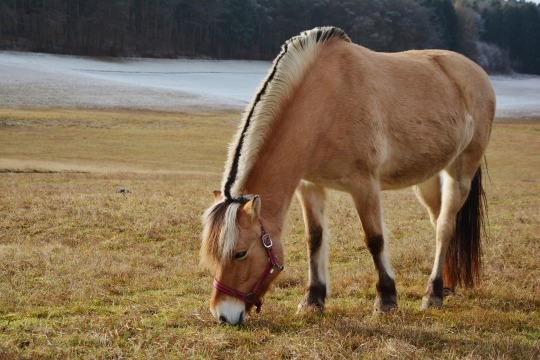
small, stocky, beautiful and quirky.. one of the oldest horse breeds in the world!! their markings are called primitive markings (dun coloring, dorsal stripe, two-toned mane and tail) and it's really striking to see in real life, too! also i just like their temperament a lot.. they're very pony-like in their stubbornness..!
Pura Raza Española

.. also called the andalusian horse, or pure spanish horse! i have a very personal reason for loving these horses (and especially this coloring, the gray dapple!) cause when i was a kid, i was on a summer camp where my.. uh.. "assigned horse" to take care of was a gorgeous PRE horse, called Navarro! he was pretty temperamental, but very gentle with me. i wasn't allowed to ride him because of his temperament, but just being with him every day was the best ;w; but aside from that, they're just... stunning to see! they move like light on clouds, they're gorgeous, and seeing them do passage is magical!! i went weekly to a stable with multiple PRE horses, and not only are they beautiful, they're also very nice to interact with. i've only had positive experiences with them..!!
Arabian Horse
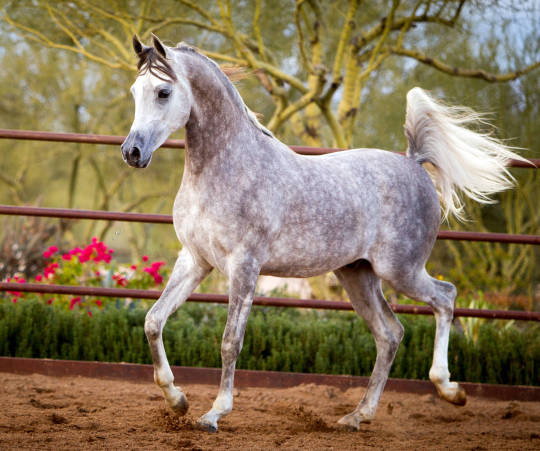
one of the oldest horse breeds, they're beautiful! smart! gorgeous! they're like, if elves were horses?? or FAIRIES... fairy horses.. literal fantasy magic horse in the flesh!! and i love the way they carry their tails like a flag!!! absolutely legendary horses.
honorary mention:
Suomenhevonen (The Finnhorse)
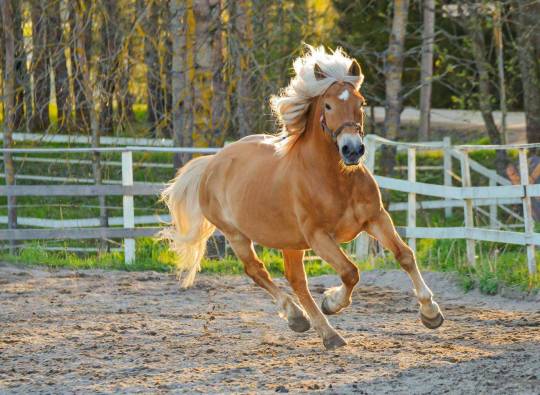
i can't not include the finnhorse. they feel like home.. they are home... i love em...
but in the end. All horses are angels. And i love them all. so much. i lvoe thmgb.........
17 notes
·
View notes
Text
De corceles y caballeros
Creo que es el momento de hablar de Lucero.
No tiene tanto tiempo como Pelayo, el mastín, sobre todo porque la raza de perro en la Península Ibérica data de antes de los romanos, como pastores —de hecho, en mi headcanon, es Roma quien le pone el nombre tras comprender que no va a convencer a España de que no se lo pueden quedar, además de otras cosas—, pero, aun así, tampoco es que sea demasiado reciente.
Lucero es un caballo tordo andaluz.

Es la imagen que más se adecúa a la que mental que tengo.
Los caballos andaluces —o andalusíes, como queráis llamarlo—, aunque hay bastante discusión al respecto, tienen su origen alrededor del siglo X por el cruce de caballos árabes con los mejores ibéricos, que ya habían tenido gran fama durante la época romana.
Su cría fue de las más preciadas, existiendo registros de varias yeguadas bastante importantes como el de las marismas de Guadalquivir o más tarde de los Mexías —que proveerían de caballos a Carlos I—, y pronto se extendió por toda la península.
Se llegó hasta el punto de que, el siglo XIII, se prohibió su cruce con asnos —no se derogaría hasta el XIX—, y en tiempos de Felipe II, este ordenó crear las Caballerías Reales de Córdoba, donde agrupó a los mejores sementales y yeguas de las tierras alrededor del Guadalquivir y marcó el inicio oficial de la raza.
También el punto de partida de una multitud de caballos americanos, como el famoso Mustang y el peruano de paso, o incluso razas europeas, como el Lipizziano, el Lusitano —más tarde incidiré en una cosa—, o el frisón.
Actualmente, se le conoce como Pura Raza Española (PRE), puesto que, a pesar de la existencia de otras variedades, es el más representativo. Es bastante apreciado en las competiciones, sobre todo en las de salto, en la doma clásica, en múltiples danzas ecuestres —por algo existe el llamado paso español—, por su conocida elegancia, y por su ancho y musculoso cuello.
Y, tras esta pequeña introducción, volvamos a principios del siglo XI, más concretamente a cuando España se encuentra a un pequeño y torpe potro negro, con una mancha blanca en su frente, cejas y hocico, en las proximidades de la frontera con la taifa de Toledo.
Intentando permanecer escondido entre los árboles, él lo atisba a cuatro patas, con sus piernas temblorosas. Pelayo le ladra, lo que hace que el animal intente huir y sus rodillas cedan.
España —que tenía más o menos entre 11 y 12 años de aspecto—, se apiada de él y se aproxima con lentitud con una manzana en las manos. Y, aunque el potrillo le echa las orejas hacia atrás y trata de ponerse en pie, no le queda más remedio que contemplar cómo él hinca una rodilla en el suelo y le ofrece la manzana.
Tras varios minutos de duda y en los que España ha permanecido completamente quieto, el potro decide darle un pequeño mordisco en la manzana. Al dirigir sus expresivos ojos hacia España y ver que este no hace más que sonreírle, el animal continúa comiéndose la fruta sin ningún tipo de apuro, y, una vez que ha terminado, permite que el niño envuelva su cuerpo con sus manos y lo ayude a ponerse en pie.
Una breve caricia en su cuello, acompañada por un gesto de su mano, y España empieza a alejarse con Pelayo, que lo ha esperado sentado desde una distancia prudencial.
Sin embargo, el potro lo sigue.
Y, por más que España intente espantarlo, continúa insistiendo.
Así que al final decide quedárselo, porque cualquiera de los linajes de los que pueda venir es bastante bueno y no le vendría nada mal un caballo.
Le pone el nombre de Lucero porque así es como se les llama a los caballos —y a los toros, pero no viene al caso—, que tienen una franja blanca surcando su frente. Sí, muy original él. Pero el niño se siente orgulloso, ¿vale? Y nadie le va a quitar esa ilusión. Además, le sorprende lo mucho que resalta ese blanco puro sobre el negro brillante de su pelaje.
Sin embargo, y esto sería algo que aprendería ya más mayorcito, la mayoría de los potros con una franja blanca en múltiples zonas de su rostro, da igual de qué color sea el resto de su cuerpo, se terminan descoloriendo durante su crecimiento hasta volverse como el caballo que veis en la foto; un tordo con todas las de la ley.
Y, a pesar de que en un principio le resultaría decepcionante que se hubiese descolorido, tampoco le terminaría dando tanta importancia. Al fin y al cabo, aquel es su querido caballo, hábil, elegante e incluso a veces tan temperamental como él.
(Además, tengo el headcanon de que la mayoría de naciones de niños terminan rodeados de animales porque son los únicos «amigos» a los que les pueden «transmitir» la inmortalidad y que los pueden acompañar durante el resto de su vida).
Como última curiosidad, y debido a Dulce y salvaje Hibernia, me gustaría compartir que Aoife, la yegua —o prácticamente hermana, puesto que fue un regalo de su padre cuando era aún muy pequeña—, de Irlanda, es un Irish Cob.

No voy a mentir; este fue el modelo.
Y el caballo de Portugal, Dinis —nombre algo curioso porque se lo encontró junto a un barril de vino, pero eso es otra cosa—, es también un caballo andaluz, bayo, aunque recibe el nombre de Lusitano porque, al final del siglo XX, 1966 concretamente, España prohibió que Portugal siguiese inscribiendo a sus caballos como andaluces, así que el país les cambió el nombre a Lusitanos.
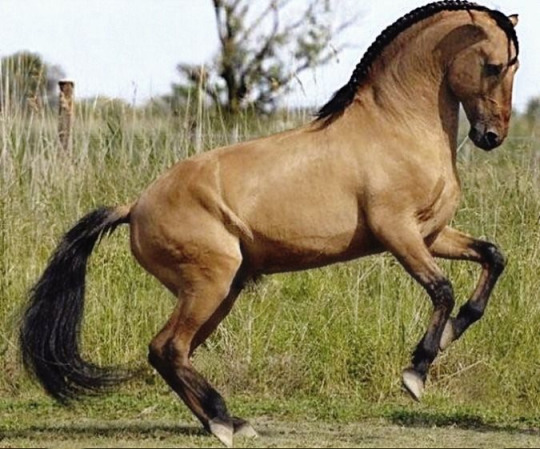
Y podría seguir hablando sobre que Inglaterra tiene un alazán inglés llamado William o que Francia tiene un camargue palomino que recibe el nombre de Charles, pero... Yo creo que es suficiente con el tema de los caballos.
#aph spain#hws spain#aph ireland#hws ireland#aph portugal#hws portugal#historical hetalia#desvaríos#caballos#(no le prestéis atención a los pequeños detalles que no tienen sentido)
15 notes
·
View notes
Photo



Fugitivo XII - Andalusian Stallion
140 notes
·
View notes
Text
Woke up on my planned day off and saw I had a million texts from my friend, took one look at the subject and threw myself and Zelder in the car and drove with all my might…
Was it worth it?

Yes.


Yes it was.
#he is… all new! fresh! fresh baby!#about two-three hours old here!#i can’t wait for him to grow and to get to know him and train with him and go on adventured with him#horse#foal#newborn foal#PRE horse#pura raza española#pura raza española horse#pura raza española foal#PRE foal#horse tag#equestrainlife#equestrian tag
10 notes
·
View notes
Photo






Matt + Emporio
#matt harnacke#emporio#andalusian#stallion#horse#dressage horse#mattia harnacke#grey horse#equestrian#paard#ruiter#PRE#pura raza española#pure spanish horse#pre stallion
246 notes
·
View notes
Video
youtube
We love this clip presenting "Horse of Kings, Thief of Hearts" a documentary by Dutch movie maker Mario Dirkx expresses some of the truly unique characteristics and romance of the purebred Spanish horse / Pura Raza Española (PRE), in some countries called the Andalusian horse because of its roots in Andalusia, Southern Spain.
It was made some years back, but it is well worth seeing again: Horse of Kings, Thief of Hearts, the Carthusian Horse
PS. If you look in the family tree of a PRE / Andalusian horse, in search of "Carthusian" (Cartujano) ancestors you might not find any. The name refers to the Andalusian monastery "La Carjuja". Look instead for brands / bloodlines such as these: Bocado, Terry, Romero Benitez, which are all pure Carthusian. DS
Horse of Kings, Thief of Hearts, the Carthusian Horse
#horse of kings#carthusian horse#andalusian#andalusian horse#pre horse#spanish horse#Pura Raza Española#pura raza espanola#pre horse origins#andalusian horse origins#spanish horse origins#terry pre#terry andalusian#bocado#bocado pre#bocado horse#bocado andalusian#terry horse#romero benitez#romero benitez horse#romero benitez andalusian#spanish horse bloodlines#andalusian horse bloodlines
12 notes
·
View notes
Photo
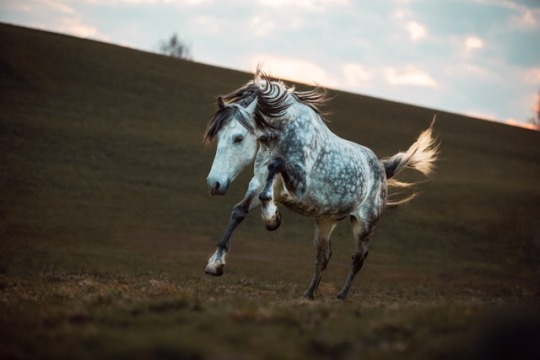
#pre#pura raza española#andalusier#andalusian#spanish horse#spanish#white horse#schimmel#caballo blanco#canter#gallop#hengst#stallion#white stallion#stallion pre#pre hengst#apfelschimmel#gray#dapples#dappled grey#meadow#paddock#barn#photography#equine photographer#equine photography#horse photographer#horse photography#shooting#photoshoot
808 notes
·
View notes
Photo


Hot boi wanted to prance
#out of shape so don’t judge the half assed passage#dressage#dressur#horseblr#pura raza española#andalusian horse#spanish horse#pre horse#prancy pony#gavilan#my horses
393 notes
·
View notes
Text
Tall PRE Andalusian Dressage Prospect, 3 Years

Tall PRE Andalusian dressage prospect for sale in Spain. Grey PRE Andalusian stallion, the son of a Reserve Champion of Spain, and nephew of an international PRE Grand Prix horse. His character is calm and friendly, with much expression and intelligence. Excellent conformation, with a perfect back and strong legs and hooves. Expected to be around 170 cm / 16.3 hh, he has three good gaits, including a very good walk and a fantastic canter. Recommended for FEI dressage or the breeding of PRE dressage or morphology horses.
Breed: Pura Raza Española (PRE). Registered in the LG-ANCCE breed registry. No piro.
Age in photo: 3 years
#PRE dressage prospect#andalusian dressage prospect#pura raza española#grey tall pre dressage horse#grey tall andalusian dressage horse
1 note
·
View note
Photo



My endless list of favourite horses: Cazurro II. [Ridden by ?? ]
#my endless list of favourite horses#cazurro ii#dressage horse#dressage#horse#grey horse#bloody shoulder#unique horse#unique#stallion#pre#pura raza española#pampero VII offspring#equestrian#equine#equus#paard#pferd#hengst#schimmel#rotschimmel#dressur#dressurpferd
33 notes
·
View notes
Photo

What a smart horse, and a very productive training!
#dressage#training#theguidetoforever#pre horse#pura raza española#horses#eq#equine#equestrian#equine life#equine photography
31 notes
·
View notes
Photo

facebook Blanka Satora show
1K notes
·
View notes
Photo



The stallion Manfredo (Desafio III x Hidalga XVI)
Born 1999
#reblog all the pres#pura raza española#pre#andalusian#baroque horse#iberian horse#manfredo#stallion#horses#horse
469 notes
·
View notes
Photo

Zhar GT, PRE mare, & colt Laureado GT
Wojtek Kwiatkowski Equine Photography
71 notes
·
View notes
Text
Animals
Hello again everybody!! I hope you well and still taking care of the pandemic, today we’re gonna talk about animals, first I tell you all about mines, my favorite animals. Anyway, we’ll start, you ready? Good.
These are some of the many animals that I like. Let’s go!!!
SNOW LEOPARD:

The snow leopard has evolved to survive under the most extreme conditions on Earth. Its grayish-white fur with large black spots blends perfectly with the texture of the rugged, rocky mountains of Central Asia.
The snow leopard's powerful anatomy allows it to climb large, steep slopes with ease. Its hind legs give the snow leopard the ability to leap the equivalent of six times its body length. Its long tail provides balance and agility, and also allows the snow leopard to shelter from the cold when at rest.
For thousands of years, this magnificent feline was king of the mountains, where prey such as blue goats, argali, ibex, marmots, rock rabbits and hares abounded. The snow leopard is found in 12 countries, including China, Bhutan, Nepal, India, Pakistan, Afghanistan, Russia and Mongolia, but its population is declining.
SPANISH HORSE:

The true origin of the Spanish Horse is not known for certain, however there is evidence that in pre-Roman times there were equestrian references in what is known today as Spain.
Roman authors such as Plutarch, Pliny the Elder and Seneca speak of the Hispanian horse as a beautiful, docile, arrogant and brave specimen, ideal for war and for the games that took place in the circuses of the time.
King Philip II ordered the horse herd of his kingdom and laid the definitive foundations for the Pura Raza Española to reach its apogee in the years to come. He achieved this through the creation of the Royal Stables of Cordoba, where he grouped together the best stallions and mares from the provinces bordering the Guadalquivir, which at that time were the most prolific in horse breeding.
Thus was born the Yeguada Real, which eventually became the Yeguada Nacional. A multitude of horses were then sent to the American continent, which had a decisive influence on their exploration, and these were the origin and basis of most of the breeds that were later bred in America.
BENGAL TIGER:
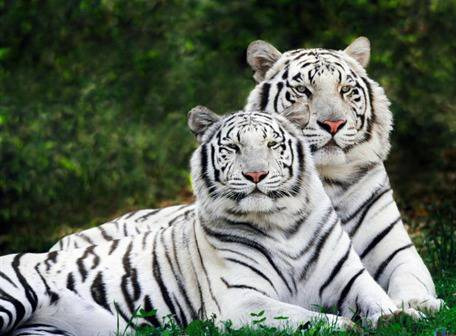
Tigers are the largest members of the cat family and are famous for their power and strength. Bengal tigers, also called Indian tigers, live in India. They are the most numerous tiger species and account for about half of the wild tiger population.
For many centuries they have played an important role in Indian tradition and culture. Tigers live solitary lives and aggressively mark large territories with their scent to keep rivals away. They are powerful nocturnal hunters, capable of traveling many kilometers to find buffalo, deer, wild boar or other large mammals.
Tigers use their distinctive fur for camouflage (no two tigers have the same stripes). They stalk patiently and approach their victims with great stealth just long enough to attack them with a quick and lethal leap. A hungry tiger can eat up to 25 kilograms in one night, although they are usually not so voracious.
That’s all for today guys, I hope you liked it, thaniks, see you all soon everyone! Take care.
3 notes
·
View notes